• Mercedes-Benz's current crop of Powerliner 2 top-weight artics bears
Page 27
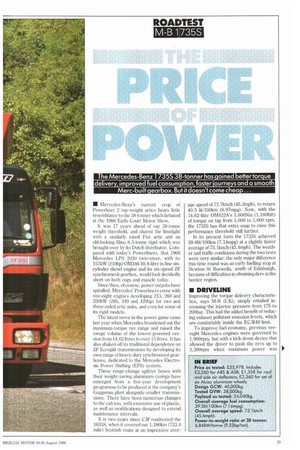
Page 28
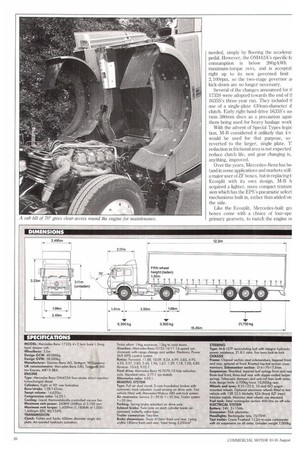
Page 29
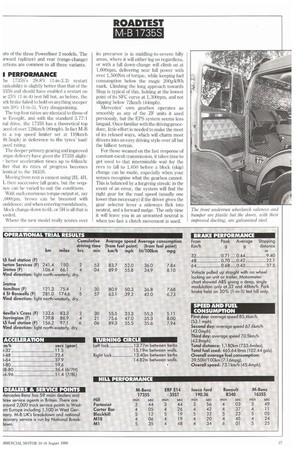
Page 30
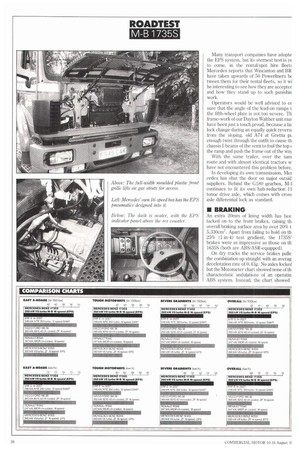
Page 31
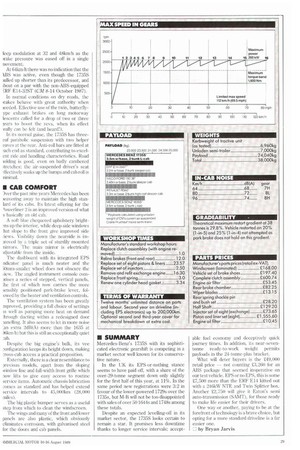
If you've noticed an error in this article please click here to report it so we can fix it.
little resemblance to the 38-hinner which debuted at the 1966 Earls Court Motor Show.
It was 17 years ahead of our 38-tonne weight threshold, and shared the limelight with a similarly rated Fiat artic and an old-looking Hino 8.5-tonne rigid which was brought over by its Dutch distributor. Compared with today's Powerliners, that 1966 Mercedes LPS 2020 twin-steer, with its 157kW (210hp) 0M346 10.8-litre in-line sixcylinder diesel engine and its six-speed ZF synchromesh gearbox, would look decidedly short on both cogs and muscle today.
Since then, of course, power outputs have spiralled. Mercedes' Powerliners come with vee-eight engines developing 213, 260 and 320kW (285, 349 and 429hp) for two and three-axled artic units, and even for some of its rigid models.
The latest move in the power game came last year when Mercedes broadened out the maximum-torque rev range and raised the swept volume of the lowest-powered version from 14.62 litres to over 15 litres. It has also shaken off its traditional dependence on ZF Ecosplit transmissions by developing its own range of heavy-duty synchronised gearboxes, dedicated to the Mercedes Electronic Power Shifting (EPS) system.
These range-change splitter boxes with their weight-saving aluminium casings have emerged from a five-year development programme to be produced at the company's Gaggenau plant alongside smaller transmissions. There have been numerous changes to the cab too, with extensive use of plastic, as well as modifications designed to extend maintenance intervals.
It is two years since CM roadtested the 1635S, when it covered our 1,180km (733.4 mile) Scottish route at an impressive aver
age speed of 72. 7km/h (45.2mph), to return 40.5 lit/100km (6.97mpg). Now, with the 14.62-litre 0M422A's 1,600Nm (1,1801bft) of torque on tap from 1,000 to 1,600 rpm, the 1735S has that extra snap to raise this performance threshold still further.
In its present form the 1735S achieved 39.61it/100km (7.14mpg) at a slightly faster average of 73.1km/h (45.4mph). The weather and traffic conditions during the two tests were very similar; the only major difference this time round was an early fuelling stop at Newton St Boswells, south of Edinburgh, because of difficulties in obtaining dery in the border region.
Improving the torque delivery characteristics, says M-B (UK), simply entailed increasing the injector pressure from 175 to 200bar. This had the added benefit of reducing exhaust pollutant emission levels, which are comfortably inside the EC/R49 limit.
To improve fuel economy, previous veeeight Mercedes engines were governed to 1,900rpm, but with a kick-down device that allowed the driver to push the revs up to 2, 30Orpm when maximum power was
needed, simply by flooring the accelerat pedal. However, the 0M442A's specific fu consumption is below 200g/kWh maximum-torque revs, and is acceptah right up to its new governed limit 2,100rpm, so the two-stage governor al kick-down are no longer necessary.
Several of the changes announced for ti 1735S were adopted towards the end of tl 1635S's three-year run. They included ti use of a single-plate 430mm-diameter d clutch. Early right-hand-drive 1635S's us■ twin 380mm discs as a precaution again them being used for heavy haulage work With the advent of Special Types legisl tion, M-B considered it unlikely that 4x would be used for that purpose, so reverted to the larger, single plate. T1 reduction in frictional area is not expected reduce clutch life, and gear changing is, anything, improved.
Over the years, Mercedes-Benz has be (and in some applications and markets still] a major user of ZF boxes, but in replacing ti Ecosplit with its own design, M-B h acquired a lighter, more compact transm sion which has the EPS's pneumatic select mechanisms built in, rather than added on the side.
Like the Ecosplit, Mercedes-built ge boxes come with a choice of four-spe primary gearsets, to match the engine ot uts of the three Powerliner 2 models. The )rward (splitter) and rear (range-change) ections are common to all three variants.
he 1735S's 29.8% (1-in-3.3) restart radeability is slightly better than that of the 535S and should have enabled a restart on se 25% (1-in-4) test hill but, as before, the ark brake failed to hold on anything steeper Ian 20%. (1-in-5). Very disappointing.
The top four ratios are identical to those of ie Ecosplit, and with the standard 3.77:1 nal drive, the 1735S has a theoretical top peed of over 128km/h (80mph). In fact M-B Ls a top speed limiter set at 119km/h i9.5mpli) in deference to the tyres' load/ peed rating.
The deeper primary gearing and improved )rque delivery have given the 1735S slight, better acceleration times up to 64krnih: fter that its rates of progress becomes lentical to the 1635S.
Moving from rest is easiest using 2H, 4H, L then successive full gears, but the sequnce can be varied to suit the conditions. With such enormous torque output at, say ,000rpm, brows can be breasted with onfidence; and when entering roundabouts, block change down to 6L or 5H is all that is ceded.
Where the new model really scores over its precursor is in middling-to-severe hilly areas, where it will either lug on regardless, or with a full down-change will climb on at 1,600rpm, delivering near full power with over 1, 500Nm of torque, while keeping fuel consumption below the magic 200g/kWh mark. Climbing the long approach towards Shap is typical of this, holding at the lowest point of its SFC curve at 1,300rpm, and not slipping below 72km/h (44mph).
Mercedes' own gearbox operates as smoothly as any of the ZE units it used previously, but the EPS system seems less languid. Once familiar with the driving procedure, little effort is needed to make the most of its relaxed ways, which will charm most drivers into an easy driving style over all but the hilliest terrain.
For those weaned on the fast response of constant-mesh transmission, it takes time to get used to that interminable wait for the revs to fall to 1,050 before a block (skip) change can be made, especially when your senses recognise what the gearbox cannot. This is balanced by a forgiving streak: in the event of an error, the system will find the right gear for the road speed (usually one lower than necessary) if the driver gives the gear selector lever a sideways flick into neutral, and a forward nudge. The only time it will leave you in an unwanted neutral is when too fast a clutch movement is used. Many transport companies have adopte the EPS system, but its sternest test is yt to come, in the rental/spot hire fleet, Mercedes reports that Wincanton and BR have taken upwards of 50 Powerliners bt tween them for their rental fleets, so it wi be interesting to see how they are accept& and how they stand up to such punishin work. Operators would be well advised to or sure that the angle of the lead-on ramps t the fifth-wheel plate is not too severe. Th frame-work of our Dayton Walther unit mm have been just a touch proud, because a fa: lock change during an equally quick revers; from the sloping, old A74 at Gretna En enough twist through the outfit to cause th chassis I-beams of the semi to foul the top the ramp and push the frame out of the wa3.
With the same trailer, over the sam route and with almost identical tractors w have not encountered this problem before.
In developing its own transmission, Met cedes has shut the door on major outsid suppliers. Behind the G180 gearbox, M-1 continues to fit its own hub-reduction 111 tonne drive axle, which comes with cross axle differential lock as standard.
An extra 20mm of lining width has bee tacked on to the front brakes, raising th overall braking surface area by over 20% t 5,330cm2. Apart from failing to hold on th 25% (1-in-4) test gradient, the 1735S' brakes were as impressive as those on th 16355 (both are ABS/ASR-equipped). On dry tracks the service brakes pulle the combination up straight with an averag deceleration rate of 0.43g. No axles locked but the Motometer chart showed none of th characteristic undulations of an operatin ABS system. Instead, the chart showed
leep modulation at 32 and 48km/h as the wake pressure was eased off in a single novement.
At 64km/h there was no indication that the IBS was active, even though the I735S
)ulled up shorter than its predecessor, and bout on a par with the non-ABS-equipped F,RF E11-32ST (CM 8-14 October 1987).
In normal conditions on dry roads, the rakes behave with great authority when iceded. Effective use of the twin, butterflyype exhaust brakes on long motorway le scents called for a drop of two or three ;ears to boost the revs, when its effect .eally can be felt (and heard!).
In its normal guise, the 1735S has threeeaf parabolic suspension with two helper eaves at the rear. Anti-roll bars are fitted at !ach end as standard, contributing to excelent ride and handling characteristics. Road
iolding is good, even on badly cambered ;.retches; the air-suspended driver's seat :ffectively soaks up the bumps and cab roll is nininral.
)ver the past nine years Mercedes has been wavering away to maintain the high slan lard of its cabs. Its latest offering for the "owerliner 2 is an improved version of what s basically an old cab.
A soft blue chequered upholstery brightms up the interior, while deep side windows
hat slope to the front give improved side Tiews. Visibility down the nearside is itnroved by a triple set of sturdily mounted nirrors. The main mirror is electrically idjustable from the inside.
The dashboard with its integrated EPS ndicator panel is much neater and the 50min-smaller wheel does not obscure the .Tiew. The angled instrument console corn.irises a series of stepped, vertical panels,
he first of which now carries the more wnsibly positioned park-brake lever, folowed by the heater and ventilation controls.
The ventilation system has been greatly mproved, providing a full choice of settings is well as pumping more heat on demand lirough ducting within a redesigned door ?anelling. It also seems to let in more noise
an extra 2dB(A) more than the 1635 at 46km/h) but this is still an exceptionally quiet :ab.
Despite the big engine's bulk, its vee :onfiguration keeps its height down, making :ross-cab access a practical proposition.
Externally, there is a clear resemblance to previous models, apart from the sloping window line and hill-width front grille which r)ow lifts to give easy access to routine service items. Automatic chassis lubrication L:orries as standard and has helped extend service intervals to 45,000km (28,000 miles).
The big plastic bumper serves as a useful step from which to clean the windscreen.
The wings and many of the front and lower panels are also plastic, which obviously eliminates corrosion, with galvanised steel for the doors and cab panels. Mercedes-Benz's 1735S with its sophisticated electronic gearshift is competing in a market sector well known for its conservative nature.
In the UK its EPS-or-nothing stance seems to have paid off, with a share of the over-29-tonne segment down only slightly for the first half of this year, at 11%. In the same period new registrations were 3:2 in favour of the lower-powered 1729s over the 1735s, but lVI-B will not be too disappointed with sales of over 50 1644s and 1748s among these totals.
Despite an expected levelling-off in its market sector, the 1735S looks certain to remain a star. It promises less downtime thanks to longer service intervals; accept able fuel economy and deceptively quick journey times. In addition, its near-seventonne ready-to-work weight permits payloads in the 24-tonne-plus bracket.
What will deter buyers is the £49,000 retail price — not counting S;3,260 for an ABS package that seemed inoperative on our test vehicle. EPS or no EPS, this is some 500 more than the ERF E 14 kitted out with a 246kW NM and Twin Splitter box. Another £2,750 will give it Eaton's semi auto-transmission (SAKI), for those ready to make life easier for their drivers.
One way or another, paying to be at the forefront of technology is a brave choice, but opting for a more standard driveline is a far easier one.
CI by Bryan Jarvis


































































































































